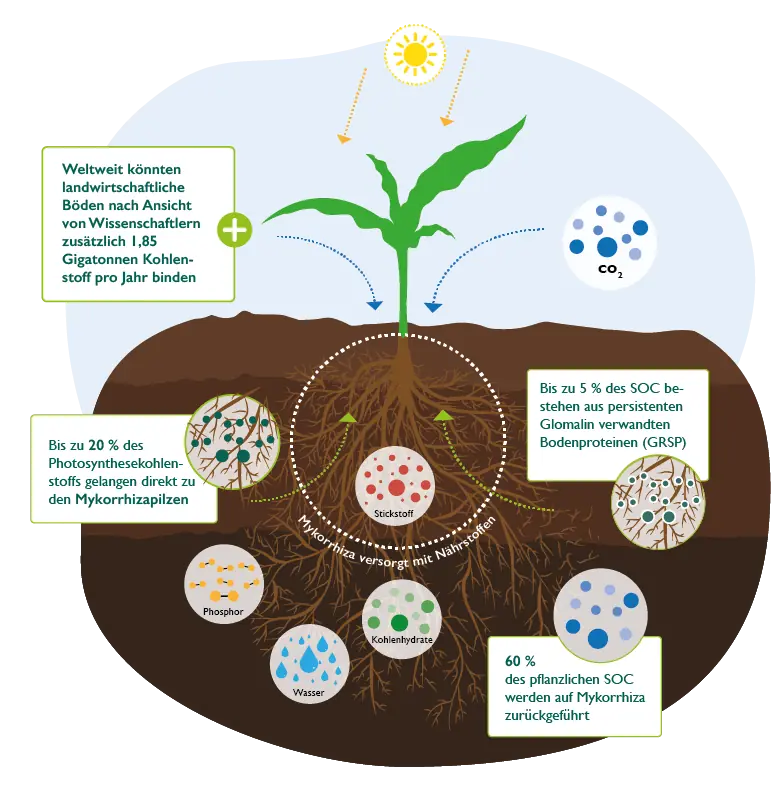CO₂-storage
Mycorrhizal fungi are the key to carbon sequestration in the soil
Exciting results on CO₂ sequestration by mycorrhiza

CO2 sequestration with plants and fungi?
Mycorrhizal fungi with their special properties as an important store of carbon.
CO₂ sequestration with plants and fungi?
Mycorrhizal fungi with their special properties as an important store of carbon
.
About 75% of all carbon on Earth is stored in the soil, and mycorrhizal fungi are crucial in bringing carbon into the soil food web. According to the researchers, mycorrhizal fungi can store a significant amount of carbon due to their special properties. This makes mycorrhizal fungi an important global carbon store, generating up to 50 % of the net primary productivity (NPP) of a plant partner in the subsoil when the host plants are associated with the most important mycorrhizal types.
The glomalin-related soil proteins (GRSP) also play a not insignificant role here, binding carbon in the soil via their compounds and having positive effects on it.

Conservation of agricultural soils through CO₂ sequestration with mycorrhiza
Mycorrhizal fungi are the bridge to soil health for all farmers who want to permanently improve and maintain their stock of organic carbon (SOC). The studies also examined how tillage affects soil properties. GRSP in particular has been shown to be a safe storehouse of carbon in the soil, even in conventional tillage systems.
How can mycorrhiza improve agricultural soils?
- Symbiosis: Arbuscular mycorrhizal fungi supply water and nutrients to plants in exchange for molecules (e.g. sugars) produced during the photosynthetic process.
- Phosphorus: Generally present in the soil in a form not available to plants - is released by mycorrhizal symbiosis and made available to the plant.
- Building up carbon stocks: Net flow of carbon into the soil is maintained, leading to a permanent supply.
- Soil health: Mycorrhiza promotes an active and vibrant microbiome. For the farmer, this means his soil remains healthy for present and future plantings and a long-term ROI (return on investment).
- Healthy soil structure: Water, minerals and nutrients can be increasingly absorbed and soil erosion prevented because organic material and clay particles are bonded by GRSP like a "super glue" to form stable soil aggregates.
Natural CO2 sequestration as climate protection
What is CO2 sequestration?
CO₂ sequestration is the storage of carbon dioxide in the deep underground/soil. In order to reduce human emissions of greenhouse gases (GHG) such as carbon dioxide in the atmosphere, various methods are used to store the GHG underground. For this purpose, geological formations such as coal seams, oil deposits, etc. have been identified as possible CO₂ reservoirs, but deep-sea storage is also being investigated. The CO₂ to be stored can come either from fossil energy supply plants, from industrial plants or from the use of biomass for energy production.
How do mycorrhizal fungi store CO₂?
Mycorrhizal fungi use carbon to form extensive networks of fine threads called hyphae. Fungal hyphae form a vast network that allows plants to draw water and nutrients from a much larger area. This living underground network contributes to the development of plants, the formation of soil ecosystems and the maintenance of the global carbon balance. In the process, different types of mycorrhizae store different amounts of carbon. The largest group of ectomycorrhizal fungi bind an estimated 9.07 billion tonnes of carbon dioxide equivalents (CO2e) per year.
Mycorrhiza as a gigantic carbon reservoir
According to scientistic Estimations the plants on land are giving up to 13.1 billion tons of CO₂ to mycorrhizal fungi. This amount accounts for about 36 percent of global annual greenhouse gas emissions from fossil fuels. And that even exceeds China’s CO₂ emissions, which are the highest in the world. The magnitude underlines the important role of fungi and soil ecosystems for climate and nature. However, it is still unclear how long the carbon is stored by the mycorrhizal fungi and how much of it is released back into the environment. The researchers therefore call for greater consideration to be given to fungi in future conservation and environmental measures, and for further research into their functions.
Sources
Hawkins, H.-J., Cargill, R. I. M., Van Nuland, M. E., Hagen, S. C., Field, K. J., Sheldrake, M., & Kiers, E. T. (2023). Mycorrhizal mycelium as a global carbon pool. Current Biology, 33(11), R560-R573. doi:10.1016/j.cub.2023.02.027
Kimbrough, L. on Mongabay, Available online at: news.mongabay.com (3. August 2023)
Source of rich informations
Our newsletter brings news about mycorrhiza directly to your desktop. A convenient way for you to learn about news in the field of research and product developments.
The INOQ team of experts is here to help
Give your plants a boost of strength.
Address
Solkau 2, 29465 Schnega
Germany
Telephone
Tel.: +49 (0) 58 42-98 16 72
Fax: +49 (0) 58 42-4 93
info@inoq.de
Business hours
Monday-Friday: 8 am to 4 pm


